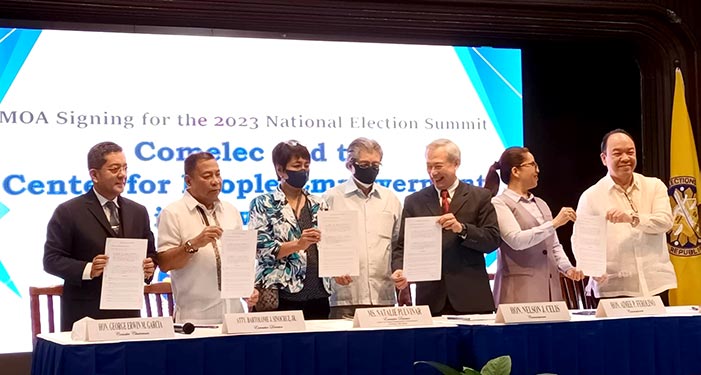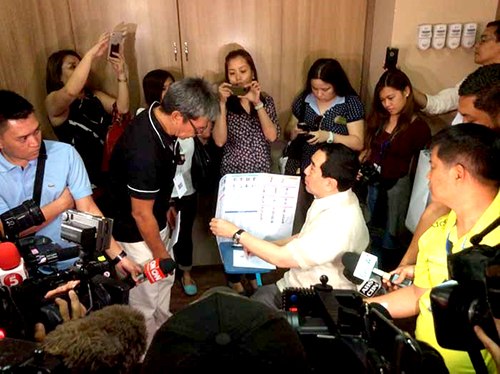Is there prospect for the hybrid election system (HES)?
Bobby M. Tuazon
CenPEG / 17 Nov. 2022
Twelve years after CenPEG called for electoral reforms including replacing the Smartmatic-outsourced Automated Election System (AES) with a Filipino-designed hybrid system, the poll body Commission on Elections (Comelec) finally convened a forum on Nov. 16 to tackle the urgency of instituting electoral changes. Held at the Pamantasan ng Lungsod ng Maynila (PLM), the forum highlighted the signing of a Memorandum of Agreement (MoA) by non-government poll stakeholders jointly with the Comelec which also provided for “the digital transformation of COMELEC and the election system”.
 Comelec chairman Garcia (extreme left); 3rd to 5th Natalie Pulvinar, Hector Barrios, and Commissioner Celis
Comelec chairman Garcia (extreme left); 3rd to 5th Natalie Pulvinar, Hector Barrios, and Commissioner Celis
CenPEG / AES Watch, represented by CenPEG Fellow on Information Systems Hector Barrios and Executive Director Natalie Pulvinar, signed the MoA. Other signatories who were also present in pre-summit focus group discussions (FGDs), were: Legal Education Board; Philippine Consortium, Inc.; Philippine Association of Fintech Lawyers; Institute of Electronics and Communications Engineers of the Philippines; One Vote Our Hope Movement; Right to Know, Right Now! Coalition; Halalang Marangal; Legal Network for Truthful Elections; Philippine Computer Society; National Citizens’ Movement for Free Elections; Parish Pastoral Council for Responsible Voting; and PLM representing the academic sector.
Atty. George Garcia, Comelec chairman, said the MoA symbolized the poll body’s aim to increase the involvement of citizens in electoral reforms. The election stakeholders are expected to put forward their proposals on electoral reforms in the first National Election Summit in January 2023.
Garcia said the Comelec is seeking the right guidance from the stakeholders. “What were our mistakes in the previous electoral exercises? What are the things we must strengthen…so that we can strengthen future elections in our country? And at the same time, what are the innovations, technological or otherwise, that the Comelec should be implementing?” he said.
Comelec Commissioner Nelson J. Celis is the designated lead representative from the poll body for the summit. Until his appointment to the poll body, Celis was a CenPEG Fellow for IT and second spokesman of AES Watch, a consortium of 40 election watchgroups, formed in 2010 with then CenPEG Executive Director Evita L. Jimenez as lead convener. (AES Watch’s first spokesman is Alfredo E. Pascual who later became UP president and now secretary of trade and industry or DTI.)
Meanwhile, Celis said issues already taken up in FGDs include election standards and information security. The poll body will conduct more FGDs on issues like internet voting, digitization, and vote-buying, all in preparation for the creation of resolutions in the January summit.
As major electoral reform partners of the Comelec, the MoA signatories: (1) will provide inputs and recommendations on the policies, plans, and programs in election administration and election enforcement and adjudication through the Pre-Summit Sessions; (2) provide concrete recommendations for the digital transformation of Comelec and the election system; and (3) commit to support the Comelec’s roadmap toward a free, orderly, honest, and credible Philippine Elections and other exercises.
CenPEG roadmap
The CenPEG struggle for electoral reform dates back to May 2009 with the publication of its policy paper on Comelec’s Automated Election System operationalized by the Precinct Count Optical Scan (PCOS) or Optical Mark Reader (OMR) technology system. The paper argued that the PCOS-OMR technology chosen by the Comelec goes against the basic democratic principle of “secret voting and public counting”. “Who controls the technology controls the votes – and power,” CenPEG warned. The automated system, the paper added, has been dropped by Germany and many other countries and reverted to the more reliable manual voting/counting with electronic transmission. (See https://cenpeg.org/2020/11-NOV-2020/CENPEG%20Policy%20Study%202009%20AUTOMATED%20ELECTIONS%20May%2007%202009%20first%20study.pdf)
Following its tight monitoring of the 2010 presidential elections with policy researchers and partners in the regions, CenPEG came out with a 60-page report which found, among others, technical glitches, lack of source code review as legally mandated, PCOS machines malfunctioning, transmission failures, and thousands of voters marginalized. The report was later presented in a public forum. (See https://www.cenpeg.org/publications/The_CenPEG_Report.html)
In a one-day conference on June 13, 2011 CenPEG and AES Watch convened the FIT4E (Filipino IT for Election) held at the University of the Philippines. The FIT4E aimed to crystallize, organize and systematize efforts of a broad network of civil society organizations, citizens’ election watch groups, IT scientists and practitioners, research institutions, professional organizations, government agencies, private entities and concerned individuals who have the mutual goal of protecting the most basic right of citizens, that is, the right to vote through the use of the latest advances in information technology as developed by local IT experts. In simple terms, to come up with a voter-friendly, efficient, secured and auditable automated voting system that will reflect the true voice of the Filipino electorate. (See, for instance, //www.cenpeg.org/2015/pp&e/JUNE2015/FIT4E=The_only_transparent_solution.html)
To prove that Filipino IT can do it, CenPEG and AES Watch in cooperation with the PLM organized a 5-hour mock voting on July 20, 2015. Showcased for the mock voting was TAPAT (for TrAnsPArenT Election System) – an alternative election technology solution developed by father-and-son tandem, Arnold and Angelo Villasanta. TAPAT uses lotto-style ballots that are scanned by the voting machine, provides each voter a verification receipt, conducts automated counting and random audit on the same day. The election returns (ERs) it will produce will then be digitally-signed by the Board of Election Inspectors (BEIs) prior to electronic transmission of the returns.

Former Comelec Chair Andy Bautista tries the TAPAT technology. (CenPEG photo)
Other voting systems demonstrated in other forums were PaTAS, as well as those first developed by De La Salle University (DLSU) IT professors and students. (See
http://www.cenpeg.org/events/july2015/FILIPINO_IT_CAN_DO_IT.html)
- Is there prospect for the hybrid election system (HES)?
- MARCOS, JR. FACES GRINDING WOES; ARE REFORMS POSSIBLE?
- Marcos, Jr. pivots to the US; faces tough economic challenges
- CenPEG’s 16th book launched
- Sisa’s Vengeance: Jose Rizal’s Sexual Politics & Cultural Revolution
- Marcos, Jr. in cryptic ties with China as he commits to U.S. defense alliance
- Philippines - a geostrategic battleground?
- The other side of Shinzo Abe: historical revisionism, denial of war crimes
- Rightsizing and reengineering bureaucracy
- Nancy Pelosi’s history of belligerency on Beijing
- Indonesian leader's China visit: Elevating bilateral relations
- 14th State of the Presidency
The Marcos, Jr. Presidency: Key Challenges from the People's Perspective - The May 2022 Elections and the Marcos Restoration: Looking Back and Beyond
- Rethinking ASEAN ties with U.S., signs of another Cold War may be in the air
- A quest for peace in Europe
- Maelstrom Over the Killing Fields
- The Russians are coming!
- Disqualification cases roil Marcos camp; biggest Left political bloc backs Robredo-Pangilinan team
- A Race for Power of Political Dynasties
- On proclaiming a winning candidate
- CLASH OF POLITICAL DYNASTIES ACCENTS MAY 2022 ELECTIONS
- The Great Faith
- We need to renew 'new politics' for the May 2022 polls
- Major Presidential Bets Formalize Candidacies but Last-Minute Surprises still Possible till Mid-November
- The shadow of Bannon in Biden's anti-China strategy
- Biden's 'Pivot to Asia' at a dead end
- Is the US aching for a war with China over Taiwan?
- Dollars for America's war machine, human losses
- Learning from an awakened dragon
- War-torn Afghanistan’s future in the hands of the Taliban
- The formidable force to contend with in 2022 elections
- With Afghan debacle, will allies trust the US?
- The Ideal OQC Operations for The 2022 elections
- RACE FOR THE 2022 PRESIDENCY GAINS MOMENTUM
- UGNAYANG PANLABAS SA ILALIM NI DUTERTE: PANALO O TALO?
- Afghanistan, where war knows no end
- A President’s Death, an ICC Call, and Realignments ahead of the 2022 Elections: A Gathering Storm?
- Simplify transmission of election results for transparent 2022 elections
- Old ways must go in May 2022 polls
- Jostling for the presidency amid the pandemic and flaws in the election system
- Clean voters’ database: A challenge to a transparent 2022 elections
- REFLECTIONS ON WOMEN AND RACE DURING THE YEAR OF THE PANDEMIC
Center for People Empowewrment in Governance (CenPEG), Philippines. All rights reserved


